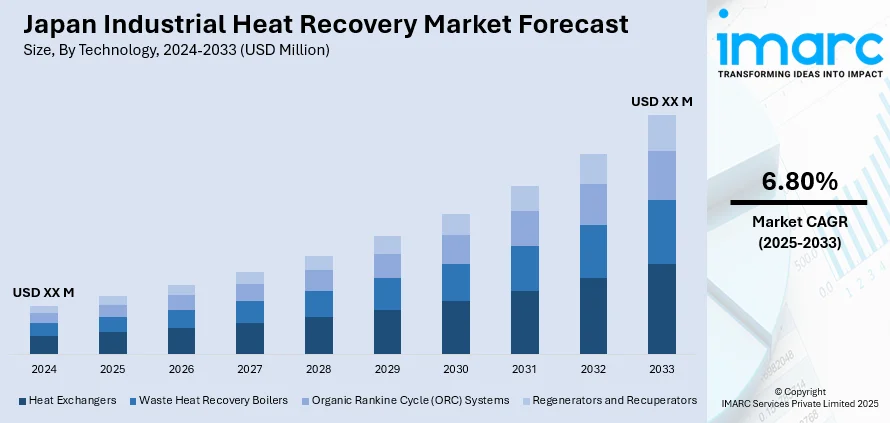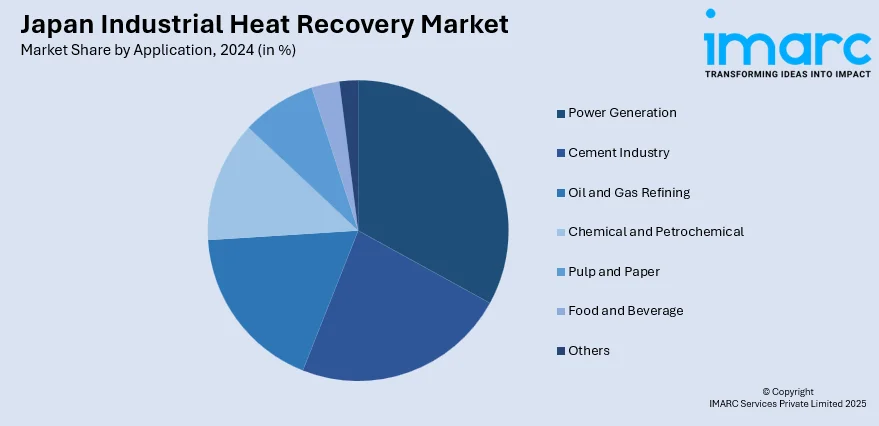
Japan Industrial Heat Recovery Market Size, Share, Trends and Forecast by Technology, Application, End Use Sector, and Region, 2025-2033
Japan Industrial Heat Recovery Market Overview:
The Japan industrial heat recovery market size is projected to exhibit a growth rate (CAGR) of 6.80% during 2025-2033. The market is driven by rising energy costs, strict environmental regulations, and the growing emphasis on energy efficiency across manufacturing sectors. Technological advancements in heat exchangers and waste heat recovery systems further support adoption. Increasing government incentives for sustainable practices and carbon reduction also contribute to market growth. These factors collectively enhance demand and competitiveness, strengthening the Japan industrial heat recovery market share.
|
Report Attribute
|
Key Statistics
|
|---|---|
|
Base Year
|
2024
|
|
Forecast Years
|
2025-2033
|
|
Historical Years
|
2019-2024
|
| Market Growth Rate 2025-2033 | 6.80% |
Japan Industrial Heat Recovery Market Trends:
Government Policies and Decarbonization Goals Driving Market Expansion
Japan's industrial heat recovery sector is heavily driven by national climate policy and decarbonization targets. The government is actively encouraging energy efficiency and urging industries to minimize their environmental footprint. By regulatory incentives, energy conservation initiatives, and funding for low-carbon infrastructure, companies are implementing waste heat recovery systems to meet these environmental requirements. This is especially evident in industries with heavy energy usage, including cement, steel, and chemicals. The demand for cleaner production processes has made waste heat recovery a go-to upgrade, rather than an optional one. As businesses move to future-proof operations against upcoming emissions regulations, the use of these systems remains on the upswing throughout Japan's industrial base.

Technological Advancements Enhancing Efficiency and Adoption
Technological advancement is taking a leading part in the increased application of industrial heat recovery systems in Japan. The new systems are more efficient, compact, and more easily integrated into current operations. Smart control technology enables real-time monitoring, optimizing, and maintenance, so they become more dependable and affordable. The enhancements provide less disruption in operations and longer system lifespans, which are attractive to businesses with continuous production operations. In addition, advances in the development of modular and adjustable systems make them deployable with flexibility in various industrial settings. In addition to enhancing the performance of heat recovery units, these advancements are decreasing the entry barriers that discouraged investment in the past. Consequently, innovation is turning these systems from specialty solutions into common industrial practices.
Industrial Sector's Shift Towards Energy Efficiency and Sustainability
Japan’s industrial sector is undergoing a fundamental shift toward sustainable and energy-efficient operations, with heat recovery emerging as a cornerstone strategy. Companies are recognizing that capturing and reusing waste heat contributes to both environmental responsibility and long-term cost savings. This approach fits well with broader corporate sustainability goals and international environmental expectations. By incorporating waste heat recovery into their energy management plans, industries are reducing reliance on fossil fuels, minimizing emissions, and improving overall productivity. The move toward sustainability is also reshaping industrial priorities, making energy efficiency an essential aspect of competitiveness. This cultural and strategic shift within the industrial sector is fueling Japan industrial heat recovery market growth driven by the growing interest and investment in heat recovery systems across the country.
Japan Industrial Heat Recovery Market Segmentation:
IMARC Group provides an analysis of the key trends in each segment of the market, along with forecasts at the country and regional levels for 2025-2033. Our report has categorized the market based on technology, application, and end use sector.
Technology Insights:
- Heat Exchangers
- Waste Heat Recovery Boilers
- Organic Rankine Cycle (ORC) Systems
- Regenerators and Recuperators
The report has provided a detailed breakup and analysis of the market based on the technology. This includes heat exchangers, waste heat recovery boilers, organic rankine cycle (ORC) systems, and regenerators and recuperators.
Application Insights:

- Power Generation
- Cement Industry
- Oil and Gas Refining
- Chemical and Petrochemical
- Pulp and Paper
- Food and Beverage
- Others
A detailed breakup and analysis of the market based on the application have also been provided in the report. This includes power generation, cement industry, oil and gas refining, chemical and petrochemical, pulp and paper, food and beverage, and others.
End Use Sector Insights:
- Heavy Industries
- Manufacturing and Processing
- Utilities
The report has provided a detailed breakup and analysis of the market based on the end use sector. This includes heavy industries, manufacturing and processing, and utilities.
Regional Insights:
- Kanto Region
- Kansai/Kinki Region
- Central/ Chubu Region
- Kyushu-Okinawa Region
- Tohoku Region
- Chugoku Region
- Hokkaido Region
- Shikoku Region
The report has also provided a comprehensive analysis of all the major regional markets, which include Kanto, Kansai/Kinki, Central/ Chubu, Kyushu-Okinawa, Tohoku, Chugoku, Hokkaido, and Shikoku Region.
Competitive Landscape:
The market research report has also provided a comprehensive analysis of the competitive landscape. Competitive analysis such as market structure, key player positioning, top winning strategies, competitive dashboard, and company evaluation quadrant has been covered in the report. Also, detailed profiles of all major companies have been provided.
Japan Industrial Heat Recovery Market News:
- In April 2025, Japan’s Ministry of the Environment launched a subsidy program to reduce price for renewable heat and industrial waste heat recovery techniques. Part of the 2024 supplementary budget, it supports energy-efficient upgrades, including non-PV renewable electricity and hot spring systems. Managed by the Japan Environmental Technology Association, applications are open until May 8, 2025. The initiative aims to lower emissions, improve efficiency, and boost adoption of sustainable heat technologies across industries.
- In April 2025, GE Vernova’s 9HA.02 gas turbines powered the new 2.3 GW Goi Thermal Power Station in Chiba, Japan, now commercially operational. The project, a joint venture with JERA, ENEOS Power, and Kyushu Electric, includes advanced Heat Recovery Steam Generators, enabling up to 50% more energy efficiency and a 16% CO₂ reduction. This modern LNG-fired plant supports stable electricity supply for 2.2% of Japan’s households.
Japan Industrial Heat Recovery Market Report Coverage:
| Report Features | Details |
|---|---|
| Base Year of the Analysis | 2024 |
| Historical Period | 2019-2024 |
| Forecast Period | 2025-2033 |
| Units | Million USD |
| Scope of the Report |
Exploration of Historical Trends and Market Outlook, Industry Catalysts and Challenges, Segment-Wise Historical and Future Market Assessment:
|
| Technologies Covered | Heat Exchangers, Waste Heat Recovery Boilers, Organic Rankine Cycle (ORC) Systems, Regenerators and Recuperators |
| Applications Covered | Power Generation, Cement Industry, Oil and Gas Refining, Chemical and Petrochemical, Pulp and Paper, Food and Beverage, Others |
| End Use Sectors Covered | Heavy Industries, Manufacturing and Processing, Utilities |
| Regions Covered | Kanto Region, Kansai/Kinki Region, Central/ Chubu Region, Kyushu-Okinawa Region, Tohoku Region, Chugoku Region, Hokkaido Region, Shikoku Region |
| Customization Scope | 10% Free Customization |
| Post-Sale Analyst Support | 10-12 Weeks |
| Delivery Format | PDF and Excel through Email (We can also provide the editable version of the report in PPT/Word format on special request) |
Key Questions Answered in This Report:
- How has the Japan industrial heat recovery market performed so far and how will it perform in the coming years?
- What is the breakup of the Japan industrial heat recovery market on the basis of technology?
- What is the breakup of the Japan industrial heat recovery market on the basis of application?
- What is the breakup of the Japan industrial heat recovery market on the basis of end use sector?
- What is the breakup of the Japan industrial heat recovery market on the basis of region?
- What are the various stages in the value chain of the Japan industrial heat recovery market?
- What are the key driving factors and challenges in the Japan industrial heat recovery?
- What is the structure of the Japan industrial heat recovery market and who are the key players?
- What is the degree of competition in the Japan industrial heat recovery market?
Key Benefits for Stakeholders:
- IMARC’s industry report offers a comprehensive quantitative analysis of various market segments, historical and current market trends, market forecasts, and dynamics of the Japan industrial heat recovery market from 2019-2033.
- The research report provides the latest information on the market drivers, challenges, and opportunities in the Japan industrial heat recovery market.
- Porter's five forces analysis assist stakeholders in assessing the impact of new entrants, competitive rivalry, supplier power, buyer power, and the threat of substitution. It helps stakeholders to analyze the level of competition within the Japan industrial heat recovery industry and its attractiveness.
- Competitive landscape allows stakeholders to understand their competitive environment and provides an insight into the current positions of key players in the market.
Need more help?
- Speak to our experienced analysts for insights on the current market scenarios.
- Include additional segments and countries to customize the report as per your requirement.
- Gain an unparalleled competitive advantage in your domain by understanding how to utilize the report and positively impacting your operations and revenue.
- For further assistance, please connect with our analysts.
 Request Customization
Request Customization
 Speak to an Analyst
Speak to an Analyst
 Request Brochure
Request Brochure
 Inquire Before Buying
Inquire Before Buying




.webp)




.webp)












